
Treating Burns Page Selection Menu: 1 2 3 4 5 6 7 8 9 10 Next>>
Treating Burns During the Golden Age of Piracy, Page 7
Burn Treatment - Medicines: Aloe/Maguey
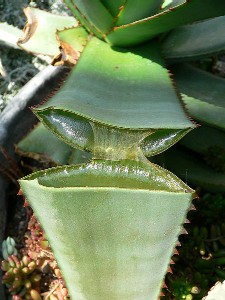
Photo: Wiki user Raul654
Clear Gel of Aloe Leaf Used on Burns
Aloes, particularly aloe vera, have long been held to have healing powers. Sea-surgeon John Moyle is the only period surgeon under study that refers directly to using aloe on burns. He proclaims that "the most eminently known and used, is that of Tinctura de Myrrhæ & Aloæ cum Croco, misce. [Tincture of Myrrh mixed with aloe and crocus]. The Navy Surgeons use much of this, and it has conduced much to the curing of great and dangerous wounds in Gun-shot."1 Moyle does not specify which of the 500 species of aloe this is, although we know aloe vera is widely used in medicines for burns.
Some of the other period sailors specify a different sort of aloe: maguey. In his account of a privateering voyage taken in 1708, Woodes Rogers explains that the maguey "leaves are admirable against Burnings; the Fruit is like Myrtle-Berries, and of an excellent Relish."2 Edward Cooke, who captained one of the vessels that accompanied Rogers also noted that the plant (which he referred to as 'Mague') was "very beautiful, the Leaves admirable against burning, the Fruit black like a Myrtle-Berry, very well relish’d, having an agreeable Mixture of Sweet and Tartness, but blacks the Mouth and Hands when eaten."3
Maguey
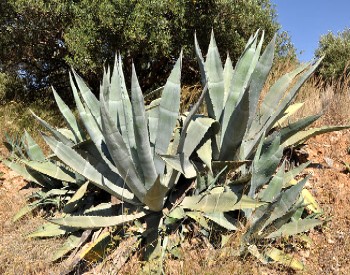
Photo: Marc Ryckaert
A Maguey or Agave Americana Plant
is also known as Agave americana, which is one of the plants which is distilled to make tequila and mezcal. (While this property may or may not help a burn, it will certainly affect your attitude towards one.)
Wikipedia notes that while maguey is referred to as an aloe, "it is not closely related to plants in the genus"4. It also turns out that the leaves of the plant can be used "to make ropes, textiles, as well as construction materials, and fuel."5 (This definitely does suggest help for burns, but it may also affect your attitude towards the plant.)
There is a great deal of speculation about the value of aloe vera in treating burns, on the other hand. Dr. Andrew Weil expresses unbounded enthusiasm for it. "The clear gel that fills the thick leaves of the succulent Aloe vera plant from Africa is a superior home remedy for burns, so useful that you ought to keep a potted aloe plant in your kitchen to have available in case of an accident."6 Scientific studies do not seem quite so sure of it's healing potential, however. According to the New York Times, while "aloe contains certain anti-inflammatory compounds and may act as an antibacterial agent... [although] studies on its effects on minor and moderate burns have been mixed."7
1 John Moyle, The Sea Chirurgeon, p. 14; 2 Woodes Rogers, A Cruising Voyage Round the World, p. 187-8; 3 Edward Cooke, A Voyage to the South Sea and Round the World in the Years 1708 to 1711, p. 66; 4 Agave americana, wikipedia, gathered 7/5/13; 5 Nicoletta Maestri, Agave Americana or Maguey, About.com, gathered from the internet 7/5/13; 6 Andrew Weil, Burns, gathered from the internet 7/5/13; 7 Anahad O'Connor, "The Claim: Aloe Vera Gel Can Heal Burns", New York Times, Sept. 8, 2008
Burn Treatment - Medicines: Butter
Butter has long been thought to be a burn curative.
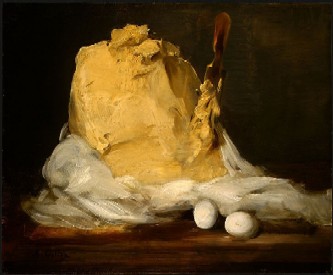
Artist: Antoine Vollon - A Mound of Butter (late 19th c.)
The basic notion during the golden age of piracy was that since butter is a cooling element and it coats the burn, it would remove the heat and lessen the pain in the wound. In his folksy collection of remedies, physician Stephen Bradwell advises the practitioner, "Against Fire or Gun-powder; Take two pounds of Butter that was never salted, melt it, & poure it into Spring-water; there beat it and wash it well."1
Bradwell later gives another recipe for a concotion featuring butter.
Take of sweet Butter newly charned, and never salted what quantitie you will; boyle in it a fit quantitie of Goose-dung; strayne it into cleare and sweet Spring-water. Doe this seaven times: and the eighth time strayn it into Rose-water; where let it remaine for the space of twelve houres. Every now and then crushing it, and working it together with very cleane hands. After that, take it out, and put it up in a Gally pot; keeping it as a precious ointment for that use. It taketh away the paine presently, and healeth with as little blemish as may be.2
In

Photo: Dr. Raju Kasambe
A Barnacle Goose Contemplating His Next Feat of Medicine
a similar manner, chemist and philosopher Robert Boyle advised the creation of an "Excellent Oyntment for Burns and Scaldings" containing "the Inner Rind of Elder-Tree, and of fresh Sheeps dung, without any adhereing straws or foulness, of each one Handful,
and with fresh Butter, or Oyl, make thereof an Oyntment"3.
Not satisfied with goose and sheep's poop, military surgeon Raymund Minderer advises his readers to "Take a Tench, or common-Pond-fish; fry one or more of them with good Butter, pour the fatness upon cold Water in a broad earthen Pan, and you have an excellent Ointment against Burnings."4
Minderer had several suggestions of prepartions using butter. He also recommended the use of "Unguentum Jovis, made of Henbane [Hyoscyamus niger], Vervain [the herb verbena] and Butter"5. In addition, he
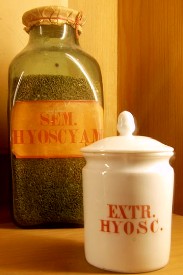
Photo Wiki User Bullenwächter:
Hyoscyamus niger - Henbane
suggests spreading "fresh butter upon Cabbage-leaves, having first fryed the Butter with some blossoms or the middle rind of Elder; and so lay them to the burning; Elder being a great
Resister of Inflammations"6.
Having all these prescriptions for butter in front of us, we might be tempted to credit butter with being a quick and easy-to-obtain burn remedy. However, modern medicine tells us this is not so, because butter "can cause infection and create an environment for bacterial growth."7 (Of course, when viewed in the beliefs of the 17th and 18th centuries, creating infection would encourage the formation of pus, one of the very things thought to help heal wounds according to humoral theory.) A holistic healing website, thirdage.com agrees that butter is probably not a cureall for burns. "While butter may afford some temporary relieve [sic] from the sting of a recent burn, it has no known antiseptic (cleansing), antibiotic (infection fighting), or long-term analgesic (pain-relieving) properties."8 From a modern scientific perspective, this once again explains why butter is not a recommended option. However, from a golden age of piracy period view, the temporary relief might recommend butter highly.
1 Stephen Bradwell, Helps For Suddain Accidents Endangering Life, p.121; 2 Bradwell, p. 124; 3 Robert Boyle, Mr. Boyle's Receipts, Vol. II., p. 61-2; 4 Raymund Minderer, A Body of Military Medicines Experimented, Volume 4 of Paul Barbette's, Thesaurus Chirurgiæ, The Fourth Edition, p. 110; 5 Minderer, p. 111; 6 Minderer, p. 111-2; 7 Pamela Curtis, "7 Trusted Injury Treatments That Are Dead Wrong", Reader's Digest, gathered from the internet, 7/5/13; 8 "True or False: Applying Butter to a Burn Aids Healing and Relieves Pain", thirdage.com, gathered from the internet, 7/5/13;
Burn Treatment - Medicines: Camphor
Camphor is an extract from the wood of the evergreen tree camphor laurel [cinnamomum camphora].1 Anyone who has ever used it would instantly recognize its pungent odor.
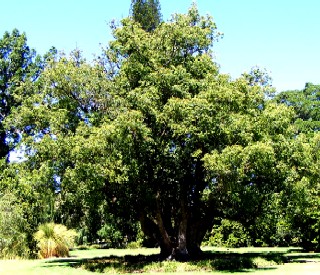
Photo: Wiki User Peripitus - Cinnamomum Camphora Tree
One of physician Stephen Bradwell's burn treatments suggests mixing "twelve ounces of fine powder of Brimstone, the seeds of Coucumbers made into fine powder, and Camphor also in fine powder, of each halfe an ounce. Mix all together with the Butter, and keepe it as an Oyntment."2 Sea-surgeon John Moyle also recommends it "for Inflamation, whether of Wounds, Burns or Scalds, you must have Ung. Alb. Camph. & Populeon. [unguent made of white camphor and black poplar buds]"3
Camphor has something to offer in the way of modern burn treatment. Wikipedia explains that it is "readily absorbed through the skin and produces a feeling of cooling similar to that of menthol, and acts as slight local anesthetic and antimicrobial substance."4 Based on this behavior, it is truly a 'refrigerant' in the humoral scheme.
WebMD suggests
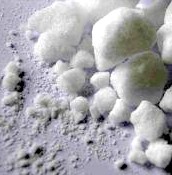
Camphor
that it can be used on minor burns, since it can be "used topically to increase local blood flow and as a 'counterirritant,' which reduces pain and swelling by causing irritation."5 This makes it an anodyne [pain-relieving] medicine as well as a refrigerant which backs Moyle's statement that it is anti-inflammatory.
Camphor is toxic in large doses, however. WebMD advises that it shouldn't be applied "to broken skin, because it can enter the body quickly and reach concentrations that are high enough to cause poisoning."6 This was actually recognized during period; in his Pharmacopeia, James Rennie advises that it was poisonous in large doses, "over-exciting the brain and nerves."7 He recommended antidotes to camphor of "wine and opium."8
6 James Rennie, A New Supplement to the Pharmacopœpias of London, Edinburgh, Dublin and Paris, Baldwin and Cradock, p. 61; 2 Stephen Bradwell, Helps For Suddain Accidents Endangering Life, p.121; 3 John Moyle, The Sea Chirurgeon, p. 17; 4 Camphor: Medicinal, wikipedia, gathered 7/5/13; 5 Camphor: Uses, WebMD, gathered 7/5/13; 6 Camphor, gathered 7/5/13; 7 Rennie, p. 61; 8 Rennie, ibid.
Burn Treatment - Medicines: Eggs
Eggs,
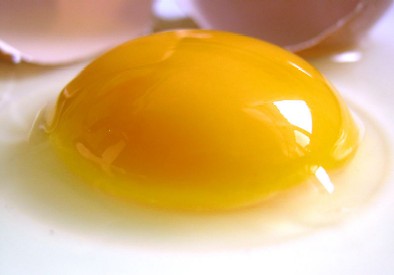
Photo: Joăo Estęvăo A. de Freitas -
A Raw Egg, Up Close and Personal
particularly egg-whites, have a long history of being a burn treatment. Several golden age of piracy era authors recommended eggs in various forms in such cases.
As befits his book on home-based remedies, Stephen Bradwell leads the recommendations in his advice on treating scaldings: "Take the White of an egge or two or more of them, according to the largenesse of the hurt: Beat it with a sufficient quantitie of oyle of Roses"1.
Sea-surgeon John Woodall gives his readers a somewhat intricate concotion containing egg white to be used to get the burn to suppurate: "Ceratum refrigerans Galeni, populeon [cold cream] mixt with a third part of Unguentum album [white salve], or a third part of Triapharmacon [Unguent of Nutritum – made of litharge, olive oil and acetic acid] and Oyle of Roses, or Oyle of Eggs, or of Roses mixt with the white of an egge"2.
Military surgeon Richard Wiseman
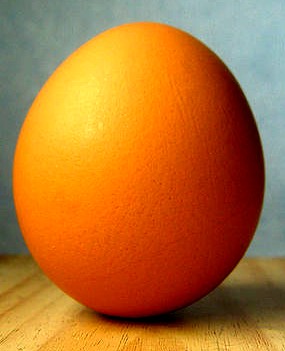
Photo: Kacper Aniołek - A Brown Egg
uses the yolk for a different purpose in one version of his burn treatment regime, while also relying on egg whites for another. He suggests healthy tissue can be built in deeper burn wounds "with Yolk of an egg and a little terebinth. lot. in aq. solani, [Spirit of turpentine in bittersweet water - made from solanum dulcamara] adding some farin. hord. [wheat flour] finely seared cum ol. amygdale. dulc. [charred with oil of bitter and sweet almonds]."3 In other cases, "I used unguent. album. camph. [white camphor unguent] mixed cum albumine ovi [egg white]."4 Fellow military surgeon Raymund Minderer concurs with Wiseman's initial prescription, revealing that "Yolks of Eggs and Linseed-oyle, equal quantities, mixt together, and spread over the burning, is also very good."5
So how do eggs stack up according to modern medicine? According to the myth-busting site snopes.com, not very well. They do admit that that eggs can function temporarily as a protective cover for minor burns which "would keep contamination out of a raw wound, not [work] as a magical curative of burned flesh."6 Of much greater importance to immediate burn treatment is running the burn under cold water, which is widely recognized as the first step in such cases.
There is another problem with eggs, although not one which surgeons 300 years ago would have understood very well. A contaminated egg runs the risk of infecting an open burn wound.7
1 Stephen Bradwell, Helps For Suddain Accidents Endangering Life, p.120; 2 John Woodall, the surgions mate, p. 145; 3 Richard Wiseman, Of Wounds, Severall Chirurgicall Treatises, p. 442; 4 Wiseman, ibid.; 5 Raymund Minderer, A Body of Military Medicines Experimented, Volume 4 of Paul Barbette's, Thesaurus Chirurgiæ, The Fourth Edition, p. 111; 6 Barbara Mikkelson, The White Albumen, gathered from the internet on 7/5/13; 7 Mayo Clinic Staff, Burns: First Aid, gathered from the internet on 7/5/13
Burn Treatment - Medicines: Mel Saponis (Honey of Soap)
Another herbal remedy, parts of which are still recommended today is mel saponis. This is prepared by taking "common soap, and honey, of each four ounces; salt of tartar [potassium carbonate], half an ounce; fumitory-water [water infused with Fumaria], two drachms. Mix them together."1
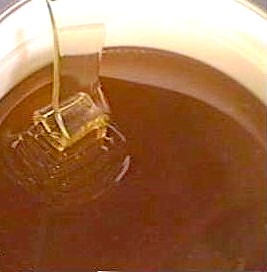
Photo: Emmanuel Boutet
Sea surgeon John Woodall advises that "to asswage bothe the dolor thereof, and the vitious humors [in a burn], Mel Saponis is an approved remedy, for it taketh the fire out."2 Fellow sea surgeon John Moyle gave the following prescription for a burn: "Rx. mel. Sapon Ungt. Nutrit. ana. [an unguent of honey combined with soap] {3 ounces}. Sacchar. Saturn. [lead acetate] {15 grains} misce."3 He applied this to small, soft pieces of lint. A third sea surgeon, John Atkins, also recommends its use, advising the reader to take "Mel Sapenis, covering the whole with a thin Linnen spread on the same, melted Hogs-Lard"4.
None of the surgeons under study suggest applying plain honey to a wound, although this is regarded by naturalists as a remedy today. This claim actually has merit according to the New York Times. From their research, "scientists have found that honey has antibacterial and anti-inflammatory properties that may promote healing. One study in 2006, examining results of more than a dozen previous studies, found that small, nonserious burns healed faster when treated with gauze and a dash of honey, on average, than those treated with antibiotic creams and other dressings."5
Natural medicing proponent 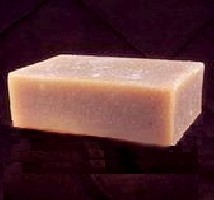
Period Soap
Dr. Andre Weil gives honey an even bigger reputation, claiming it "can be spectacularly effective for severe burns and is the basis of a therapy in China that has attracted much attention from doctors in the West."6 However, he also warns that store-bought honey shouldn't be used. Instead the reader is advised to seek out manuka honey which he claims was used in uncited New Zealand research.
Soap is also suggested for modern use when cleansing burns with water.7 In modern practice, soap's primary purpose is to clean, not to provide medicinal treatment. Unfortunately, our period surgeons give no detail on why soap was included in the mel saponis used to treat burns. As we will see, some period surgeons do recommend astringent medicines in treating burns. However when mel saponis is mentioned here, it appears more as a curative. So the reason for including soap in it is unknown.
2 John Quincy, Pharmacopoeia Officinalis & Extemporanea, p. 409; 2 John Woodall, the surgions mate, p. 145; 3 John Moyle, Memoirs: Of many Extraordinary Cures, p. 116; 4 John Atkins, The Navy Surgeon, p. 176;; 5 Anahad O'Connor, "The Claim: "Honey Can Soothe a Burn", New York Times, Feb. 19, 2008; 6 Andrew Weil, Burns, gathered from the internet 7/5/13; 7 See for example Burns: Cleansing the Wound, Children's National Medical Center, gathered from the internet 7/8/13
Burn Treatment - Medicines: Milk
The topical application of milk to a burn is another long-standing homeopathic remedy for minor (1st and 2nd degree) burns.
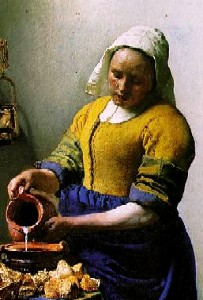
Artist: Johannes Vermeer
Stephen Bradwell advises its use in scaldings, along with oil (which we'll look at shortly), lye "or any other Liquor [liquid]"1. Military surgeon Raymund Minderer also recommends it, advising the reader to take 'Milk-cream' and "mingle it with Cow-dung freshly made, and so clap it on, though fresh Cow-dung alone allays burning."2 None of the other military surgeons recommend the use of milk, although this may have been due more to lack of availability than anything else. It certainly could have been hard to come by on a sailing vessel.
Milk has wide support on home remedy sites. At health911, they advise its use on first degree burns. They recommend that their readers "soak the burned area in whole milk for 15 minutes or so. You may also apply a cloth soaked in milk to the area. Repeat every few hours to relieve pain. Be sure to wash out the cloth after use, as it will smell badly."3 A posting by a reader of another homeopathic website suggests that the "fat content in the milk soothes the burns and promotes healing."4
No reputable medical source seems to advocate for or against the use of milk, suggesting it may be harmless. Since the first widely supported step for burn treatment at home is to run the wound under cold water, milk's healing properties probably have more to do with the cold temperature of the liquid than repeated use or fat content.
1 Stephen Bradwell, Helps For Suddain Accidents Endangering Life, p.120; 2 Raymund Minderer, A Body of Military Medicines Experimented, Volume 4 of Paul Barbette's, Thesaurus Chirurgiæ, The Fourth Edition, p. 112; 3 Burns: Remedies, health911.com, gathered 7/5/13; Kevinp, Home Remedies For Burns, thestreet.com, gathered 7/5/13

